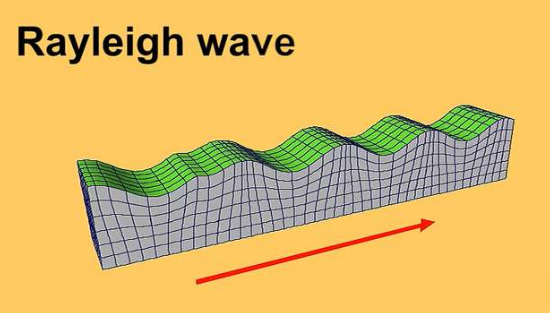Seismic wave
A seismic wave is a wave that travels through the Earth (within or along its surface), often as the result of an earthquake, explosion or similar energetic source. There are two kinds of seismic wave: Body wave and surface wave.
Body wave
Body wave is a seismic wave that propagates within Earth. There are two class of body waves: Primary (P-waves) and secondary (S-waves).
Primary wave
P wave or compressional wave, is a longitudinal wave that can be transmitted by both solid and materials in the Earth’s interior. This is the fastest types of seismic wave, and, therefore, the first to ‘arrive’ at a seismograph or seismic station. They are shake the medium in the direction in which they are propagating.
Secondary wave
S waves or Secondary waves, are shear waves and they are the second waves to arrive during an earthquake. They are much slower than P waves and can travel only through solids. They are shake the medium in the direction perpendicular to which they are moving.

Surface wave
Surface wave is a seismic wave that propagates in the surface of the Earth and along the interface between different media. There are two types of surface waves: Rayleigh wave and Love wave.
Rayleigh wave
Rayleigh wave is a type of seismic surface wave propagated along the free surface of a semi-infinite medium. Their motion is a combination of longitudinal compression and dilation that results in an elliptical motion of points on the surface. Also, its amplitude decreases exponentially with depth, and the elastic properties to a depth of about one wavelength determine its velocity.

Love wave
They are propagated when the solid medium near the surface has varying vertical elastic properties. Displacement of the medium by the wave is entirely perpendicular to the direction of propagation and has no vertical or longitudinal components.

Importance of surface wave
Vibrations generated during an earthquake are often dominated by prominent surface waves, the propagation of which is strongly influenced by site conditions. The effects of soil properties on the shape, amplitude and duration of seismic waves are namely site effects, which can generate both human and economic losses.
As characterization of site conditions based on the surface wave has become increasingly important, several methods have been proposed in the literature to estimate average of the S-wave velocity over the first thirty meters (Vs30), the distribution of the S-wave velocity with the depth and sedimentary thickness.
Some methods used are: ReMi or refraction of microtremor, MASW (Multichannel Analysis of Surface Waves), Inversion of seismic noise data, etc.
Reference:
https://www.britannica.com/science/
https://wiki.seg.org/wiki/Dictionary:Rayleigh_wave
Narciso, J., Vilanova, S, Lopes, I., Oliveira, S., Carvalho, J., Pinto, C., Borges, J. & Nemser, E. (2012). Developing a Site-Conditions Map for Seismic Hazard Assessment in Portugal. 15 WCEE, Lisboa.
Congratulations @seismicsoft! You have completed some achievement on Steemit and have been rewarded with new badge(s) :
Click on any badge to view your own Board of Honor on SteemitBoard.
To support your work, I also upvoted your post!
For more information about SteemitBoard, click here
If you no longer want to receive notifications, reply to this comment with the word
STOPDo not miss the last announcement from @steemitboard!